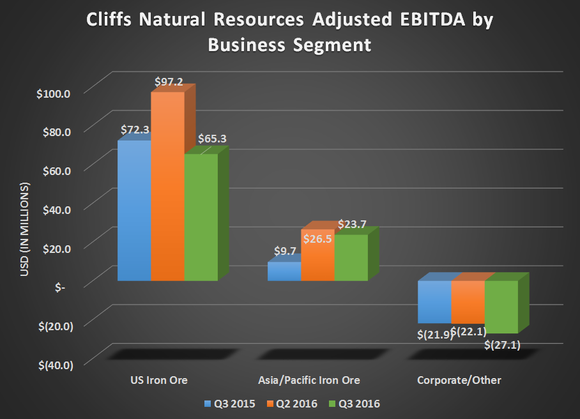Wall Street Overreacted to Cliffs Natural Resources' Third-Quarter Loss
There are a
couple things baked into the decline in earnings that make the numbers look a little worse than the
overall situation at the company. The first is that the company took a loss on the extinguishment of
some of its debts. This was one of those temporary hits that a company should take, because the payoff
lowered annual interest expense payments by $17 million annually, and it means that the next-term notes
due aren't until 2020. This gives the company lots of time to improve its profitability before any more
debts come due.
Another thing that lowered earnings this quarter
were some costs at its U.S. Iron Ore operations related to the restart of one of its United Taconite mines.
These costs will likely be worth it, as Cliffs anticipates it will need production to meet increasing demand
in 2017.
EBITDA = EARNINGS BEFORE INTEREST, TAXES,
DEPRECIATION, AND AMORTIZATION. DATA SOURCE: CLIFFS NATURAL RESOURCES EARNINGS RELEASES. CHART BY
AUTHOR.
The news that should be encouraging to investors
is that the company is increasing its sales guidance for 2017. According to management, customer demand has
already fully subscribed to its annual production levels, and it will likely draw down on iron-ore
inventories.
Management's path forward
When CEO Lourenco Goncalves was brought on to run
Cliffs a few years ago, the company was in rough shape. It had an extremely bloated balance sheet and a
bunch of unprofitable assets that were dragging down the business. These past couple years, Goncalves has
shed these assets and has reduced the company's debt load. With much of that work having an impact on the
bottom line, Goncalves highlighted where he sees the company going from here:
For two years, we have been in the process of
tackling the many pressing issues we have faced: volume uncertainty, competitive threats within the Great
Lakes, loss-making non-core assets, Bloom Lake, a bloated cost structure, and a near-term debt maturity is
tearing us in the face. We have moved past all of these problems.
So a question we are getting more often is,
what's next? Well, let me lay out what we now have in front of us. On the financial side, we have done a lot
to reduce debt, clearing over $1.1 billion over the last two years despite minimal cash flow generation. Now
just imagine what we can do next year, when we're actually generating free cash. We want to make our balance
sheet bulletproof to withstand the cyclical downturns that are so common in this industry. And to get to
that point, we still have more work to do. With that in mind, debt reduction and maturity extinction remain
our top capital-allocation priorities. To the extent we do generate free cash flow in the future, we expect
to be deployed toward these goals.
On the strategic side, we acknowledge that the
electric-arc furnace mills account for nearly two-thirds of steel production in this country. In order for
Cliffs to be around for another 100 years, we need to evolve to the point that we are supplying and actively
involved with the EAF side of the business.
The point about electric-arc furnaces and their
future in the American market can't be overstated. Not only do these types of furnaces figure in a large
majority of the steelmaking process in the U.S., they are also a much more profitable method of making
steel. The companies that use traditional blast furnaces have been barely treading water these past five
years, while those companies that focus exclusively on electric-arc furnaces have remained mostly profitable
this whole time.
What a Fool
believes
Cliffs will likely need to incur some capital
costs to upgrade its iron-ore pellets such that they are suitable for electric-arc furnaces. In the long
run, though, this is clearly the direction the company needs to move if it wants to supply American steel
producers, because it's where the industry is heading.
This negative turn in earnings for the quarter
was a bit of a bummer, but some of the reasons for that slide look to be temporary. Things are certainly
looking up, as the company plans to increase production and draw down inventories in 2017. If Cliffs can
continue to keep its costs low, then investors should expect a return to profitability, as well as further
extinguishment of debt that will make the company much better positioned to withstand the ups and downs of
the commodity market. All this seems to suggest that investors shouldn't take Cliffs' big stock slide after
earnings as a bad sign.
10 stocks we like better than Cliffs
Natural Resources
When investing geniuses David and Tom Gardner have a stock tip, it can pay to listen. After all, the
newsletter they have run for over a decade, Motley Fool Stock Advisor, has tripled the
market.*
David and Tom just revealed what they believe are
the ten best stocks for investors to buy right now… and Cliffs
Natural Resources wasn't one of them! That's right -- they think these 10 stocks are even better
buys.










